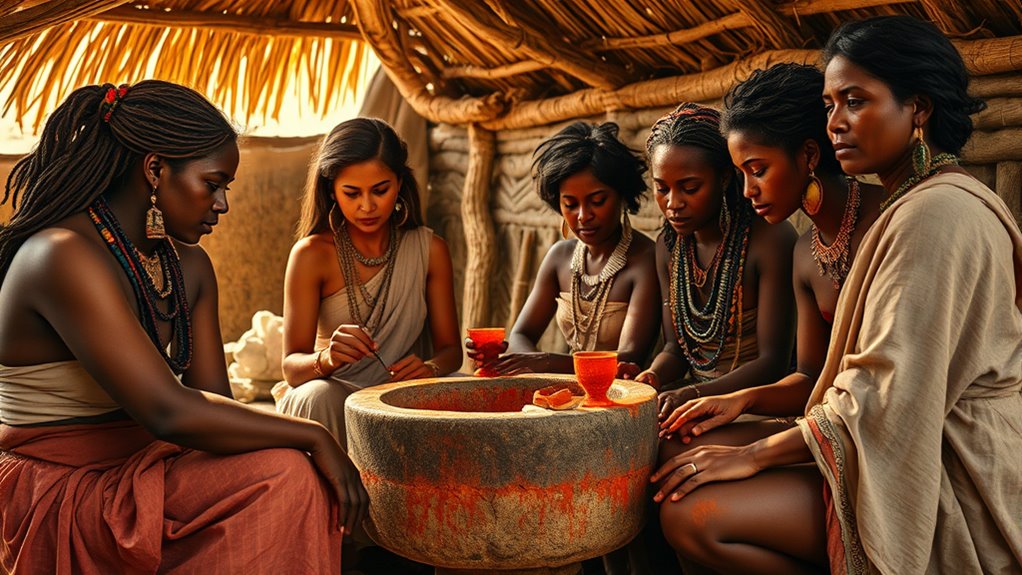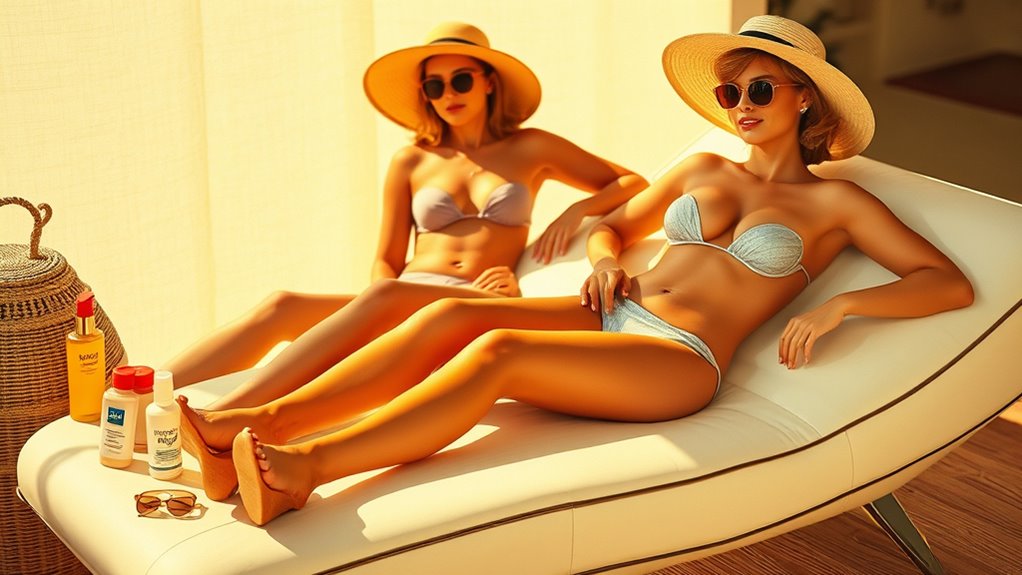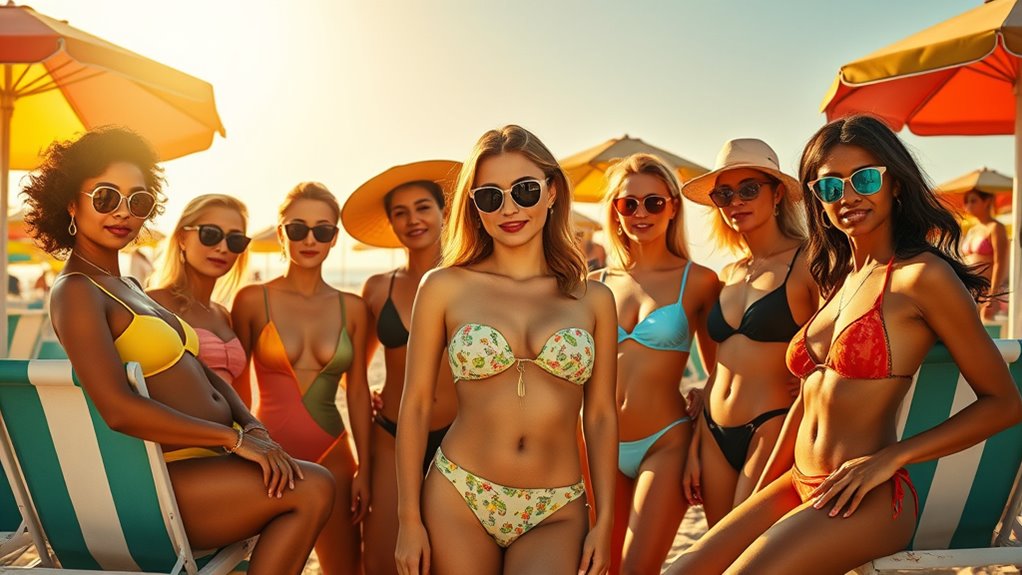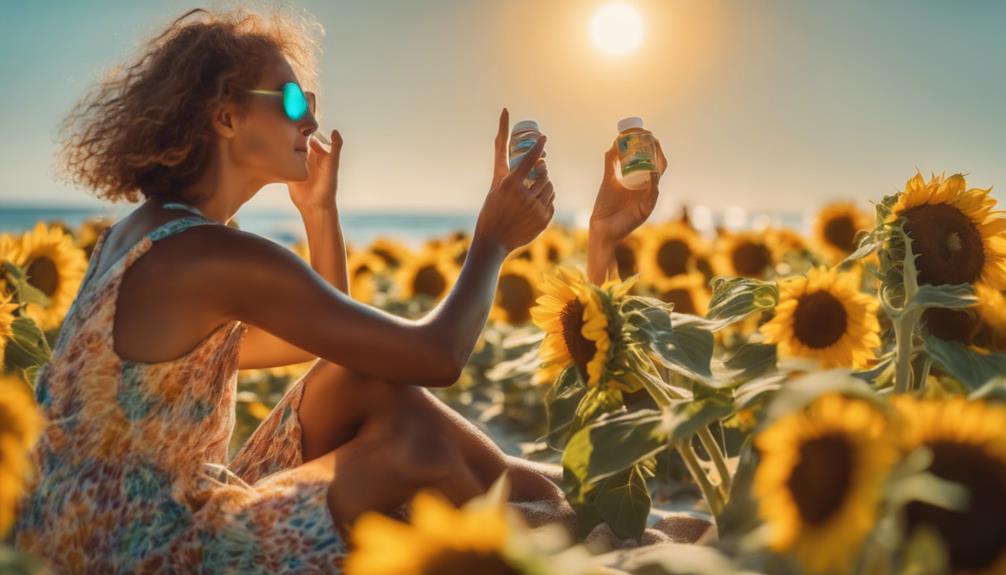Tanning fashion started as a sign of wealth and leisure in the early 20th century, shifting from pale skin symbolizing high status to a tanned look associated with health, vigor, and outdoor leisure. Influenced by celebrities like Coco Chanel and media campaigns, tanning became a popular trend worldwide. Technological advances and industry growth keep fueling the trend, while cultural differences, like East Asian preferences for pale skin, show how diverse tanning ideals remain. If you continue exploring, you’ll uncover even more fascinating insights.
Key Takeaways
- Tanning shifted from a sign of manual labor to a symbol of health and leisure in the 1920s.
- Hollywood icons of the 1950s popularized bronzed skin as a sign of vitality and status.
- Early 20th-century Western elites associated pale skin with wealth, leading to sun avoidance practices.
- Coco Chanel’s 1923 sunburn trend made tanning fashionable, challenging traditional beauty standards.
- Modern media and influencers continue to glamorize tanning, blending fashion trends with cultural perceptions.
Ancient Views on Skin Color and Beauty

In ancient times, societies across Europe, Asia, and North Africa held clear ideas about skin color and beauty. Light skin, especially in women, symbolized privilege, noble status, and beauty. In Greece, women and goddesses were often depicted with pale skin, seen as the ideal of beauty. Men with tanned or darker skin represented strength and courage, while overly pale men appeared weak or effeminate. Greek literature highlighted goddesses like Hera and Aphrodite with white skin, reinforcing their divine beauty. The preferred male skin tone was a moderate tan, indicating vitality and valor without excess. These ideals reflected societal roles, with lighter skin linked to high status and indoor refinement, while darker skin signified outdoor labor and lower social standing. Understanding ancient beauty standards reveals how societal values influenced perceptions of skin tone and attractiveness. Additionally, the cultural significance of skin color often persisted through various historical periods, shaping beauty ideals over centuries. The association of skin tone with social class and morality also contributed to enduring beauty ideals across different civilizations. Recognizing these historical perspectives helps us understand how societal perceptions of beauty continue to evolve today.
The Rise of Tanning as a Fashion Statement in the Early 20th Century

As the 1920s unfolded, attitudes toward skin tone shifted dramatically, transforming tanning from a sign of manual labor into a fashionable statement of health and leisure. Previously, pale skin symbolized wealth and refinement, while tanned skin was linked to manual work and lower social status. Women protected their skin with parasols, hats, and covered clothing, and skin lightening products were widely marketed. However, a cultural change emerged between 1927 and 1929, with magazines like Harper’s Bazaar celebrating tanning techniques. Coco Chanel’s accidental sunburn in 1923 popularized the idea of tanning as a sign of vitality and leisure. Designers introduced tanning oils, and sunbathing became a fashionable activity associated with vacation, health, and affluence, marking a significant shift in beauty standards. Additionally, the growing awareness of the energetic alignment associated with sun exposure contributed to its popularity as a wellness practice. This shift was further reinforced by emerging cultural perceptions of the sun as a symbol of vitality and health, which helped elevate tanning to a status of fashion and social desirability. Moreover, the development of chemical tanning methods in the mid-20th century further expanded its appeal, making it accessible to a broader audience.
Coco Chanel and the Popularization of Sun-Kissed Skin

Coco Chanel’s personal experience with a sunburn in 1923 unexpectedly reshaped societal beauty standards by popularizing the idea that a sun-kissed complexion signified liveliness and modernity. Her accidental tan challenged the traditional preference for fair skin, which was a sign of wealth and leisure. Chanel featured tanned models in her fashion shows, making the sun-kissed look desirable and stylish. This shift turned tanning from a sign of lower social class into a symbol of health, wealth, and modernity. Before her influence, fair skin was revered, but her example inspired a cultural change. As a result, tanning became associated with leisure, youth, and freedom, transforming beauty ideals and sparking a widespread embrace of sun exposure as a fashion statement. Additionally, her influence contributed to the rise of tanning techniques and the development of specialized skincare products to maintain a sun-kissed appearance. The growing popularity of tanning also reflects broader societal trends of wealth and leisure becoming symbols of attractiveness and status, emphasizing the importance of cultural shifts in beauty standards and the increasing recognition of spiritual energy as part of personal well-being. These shifts were further supported by advancements in skincare technology, which helped people achieve and maintain the desired look safely.
Media’s Role in Promoting Tanning Trends

Media plays a powerful role in shaping tanning trends by constantly showcasing tanned appearances as desirable and stylish. You see this on social media platforms like Instagram and TikTok, where influencers and brands promote tanning with little mention of health risks. Many posts focus on looking good, driving comparison and dissatisfaction, especially among young people. Instagram, in particular, targets high-risk groups and often features sponsored content encouraging indoor tanning. Misinformation about “healthy tans” spreads easily, increasing risky behaviors. Campaigns using celebrities and influencers aim to counteract this, but social media trends like the #sunburnchallenge normalize unsafe practices. Overall, media influences attitudes toward tanning, often prioritizing appearance over health, which contributes to the persistent popularity of tanning despite the known dangers. Additionally, the portrayal of tanning as glamorous drives consumer demand, reinforcing the cycle of risky behaviors. The influence of media is further amplified by personality traits such as the tendency toward social comparison, which can heighten the desire to emulate idealized beauty standards. Moreover, media often highlights cosmetic ideals that emphasize tanned skin as a symbol of health and attractiveness, which can reinforce negative perceptions of natural skin tones. Recognizing the role of media influence can help develop more effective health communication strategies to combat these trends. Understanding the psychological impact of these portrayals is crucial in designing interventions that promote healthier choices.
Technological Advances in Tanning Methods

Technological innovations have substantially transformed tanning methods, making the process safer, more efficient, and more environmentally friendly. Chrome tanning revolutionized the industry by cutting processing time from months to days, enabling mass production and consistent quality. Although it raised ecological concerns due to chromium sulfate use, newer methods address these issues through water reduction techniques, chemical alternatives, and closed-loop systems that recycle chemicals and minimize waste. Sustainable practices have become increasingly important in the industry, leading to the development of more eco-friendly tanning processes. Oil tanning has also advanced, with improved odor control, cost savings, and stronger, more durable leather through cross-linking and waste utilization. Meanwhile, UV technology in cosmetic tanning now features smart timers, sensors, LED systems, and app connectivity, making tanning safer and more personalized. Upgraded equipment with hybrid systems, cooling, filters, and modular designs further enhances safety, efficiency, and user comfort. Additionally, the integration of glycolic acid products into skincare routines exemplifies how modern innovations continue to improve safety, efficacy, and user experience across related industries. The adoption of AI-driven insights in industry operations is also beginning to optimize tanning processes and environmental management. Furthermore, ongoing research into biocompatible chemicals aims to reduce harmful impacts on ecosystems while maintaining product quality. Moreover, advancements in environmentally friendly chemicals are critical for reducing ecological footprints and promoting sustainable industry growth.
Cultural Influences and Variations in Tanning Preferences

Throughout history, cultural beliefs and social contexts have shaped how different societies perceive and pursue tanning. In many cultures, lighter skin symbolized wealth and high social status, as it indicated a life indoors away from manual labor. Conversely, darker skin once signified lower socioeconomic status and outdoor work. In the early 20th century, Western elites began to associate tanning with leisure and luxury, making it fashionable among the upper classes. Beach culture and sun vacations later popularized tanned skin as a symbol of vitality and health in North America and Europe. Meanwhile, in East Asian cultures, pale skin remains highly valued, representing beauty, purity, and wealth, leading to sun avoidance. These varying preferences highlight how cultural ideals influence tanning practices worldwide. Additionally, the advent of modern UV exposure devices and tanning salons has further shaped contemporary tanning trends across different societies. Recognizing the influence of AI-driven safety measures is increasingly important in the context of tanning technology advancements. Advances in skin protection technologies are also contributing to safer tanning practices, reflecting ongoing efforts to balance aesthetic desires with health considerations.
The Impact of Celebrity and Media on Tanning Norms

Celebrities and media have played a powerful role in shaping society’s tanning standards over the past century. In the 1920s, magazines like Vogue and Harper’s Bazaar promoted tanned skin as fashionable, shifting away from pale ideals. Hollywood stars in the 1920s and 1930s popularized bronzed skin as a symbol of leisure and success, while ads linked tans to beauty and sophistication. During the 1950s and 1960s, icons like Brigitte Bardot normalized full-body tans, with magazines equating them to vitality and status. Despite rising awareness of UV risks, media often minimized dangers, emphasizing health and youthfulness associated with tans. More recently, social media trends, influencer marketing, and celebrity endorsements have kept tanning in the spotlight, often glamorizing both sun exposure and sunless alternatives.
Economic Growth and Industry Development

The industry surrounding tanning has experienced significant growth, driven by increasing consumer demand and evolving market dynamics. The global leather tanning market was valued at USD 7.5 billion in 2023 and is projected to reach USD 10.6 billion by 2031, growing at a CAGR of 5%. Similarly, the broader tanning and dyeing market is expected to grow from USD 4.81 billion in 2024 to USD 7.79 billion by 2033. Self-tanning products, valued at USD 1.15 billion in 2023, are forecasted to hit USD 1.7 billion by 2032, with a CAGR of 4.5%. While the US industry faces slight declines, emerging markets and health-conscious consumers support growth elsewhere. Innovations, sustainability efforts, and shifting fashion preferences continue to shape the industry’s development and economic impact worldwide.
Future Trends and Innovations in Tanning Fashion

As consumer preferences shift toward healthier and more sustainable options, the future of tanning fashion is driven by innovations in clean, skin-friendly formulations. You’ll see more non-toxic, natural products that avoid harsh chemicals, reducing skin irritation and promoting wellness. Ingredients like antioxidants and moisturizers are now common, aligning with organic trends and transparency demands. Personalized tanning solutions are also on the rise, with technology enabling precise skin tone analysis and custom blends, ensuring a perfect match. Mobile and at-home services continue to grow, offering convenience and privacy for consumers willing to pay a premium. Additionally, inclusive marketing promotes tanning for all skin tones, broadening the industry’s reach. Expect advanced formulas that combine hydration, UV protection, and natural build-up, enhancing user experience and safety.
Frequently Asked Questions
How Did Ancient Societies Perceive Pale Versus Tanned Skin?
In ancient societies, you see, pale skin often symbolized wealth, purity, and indoor lifestyles, while tanned skin represented strength, outdoor labor, and lower social status. For women, pallor meant beauty and virtue, whereas men’s tans showcased their active, warrior roles. You’d notice that elite classes used cosmetics to stay pale, and regional differences influenced perceptions, with some cultures valuing tan skin as a sign of vitality and strength.
When Did Indoor Tanning Become a Common Practice?
Imagine a world where tanning beds glow like futuristic lanterns—this is when indoor tanning became common. In 1977, the first salon opened in Berlin, and by the late 1980s, the US saw over 18,500 salons. You’d find people chasing that perfect glow year-round, thanks to technological advances and savvy marketing. It became a popular, trendy way to achieve a sun-kissed look, despite health concerns.
What Health Risks Are Associated With Tanning Beds?
You should know that tanning beds pose serious health risks. They emit UVA and UVB rays, increasing your chances of skin cancers like melanoma, basal cell carcinoma, and squamous cell carcinoma. Regular use raises your risk markedly, especially if you start young. UV exposure from tanning beds also accelerates skin aging, causes burns, and damages DNA, impairing your immune response. Protect your skin by avoiding indoor tanning to reduce these dangers.
How Do Cultural Differences Influence Tanning Preferences Globally?
You see that cultural differences shape tanning preferences worldwide. In Western countries, you might prefer a tanned look because it’s linked to health and leisure, while in Eastern cultures, you value pale skin as a sign of beauty and status. These attitudes influence your tanning habits and sun protection behaviors. Recognizing these cultural influences helps you understand why tanning practices vary and how they impact health choices globally.
What Sustainable Innovations Are Emerging in the Tanning Industry?
You see that the tanning industry is embracing sustainable innovations, like plant-based tannins from chestnut shells and olive leaves, reducing chemical use and pollution. You’ll notice advancements such as eco-friendly retanning agents, closed-loop systems, and low-energy processes like ultrasound-assisted tanning. These innovations help cut emissions, minimize waste, and promote circular economy practices, making leather production more eco-conscious while maintaining quality and meeting growing demand for sustainable products.
Conclusion
As you’ve seen, tanning’s journey from ancient ideals to modern trends reflects society’s shifting views on beauty and identity. Like a mirror, fashion reflects who we are and what we aspire to be. Embrace the evolving landscape, knowing that each sun-kissed glow tells a story—your story—shaped by culture, innovation, and desire. In this endless dance with the sun, your skin becomes a canvas of history and hope.









